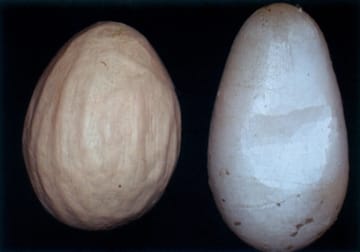The egg drop syndrome 1976 (EDS 76) is an infectious disease in layer hens manifested by a quick drop in egg production, failure to reach peak production, irregularly sharped eggs, soft-shelled or shell-less eggs and depigmentation (Image 1). The aetiological agent is an adenovirus of group III. The horizontal transmission occurs slowly in battery systems and rapidly in floor housing systems.
Image 1 The normal egg (left) & the loss of egg pigmentation (right)
The first sign is the loss of egg pigmentation, rapidly followed by the appearance of soft-shelled, shell-less of deformed-shell eggs (Image 2). If defective eggs are discarded, the remaining ones have no problem with fertilization and hatching. The drop could be sudden or prolonged. Usually, it lasts for 4 - 10 weeks and the egg production is reduced by about 40%.
Image 2 Shell-less of deformed-shell eggs
Apart the inactive ovaries and oviduct atrophy, other lesions are not discovered. The replication of the virus in epithelial cells of oviduct glands results in severe inflammatory and dystrophic changes in the mucous coat.
The appearance of eggs with impaired quality (Image 3) and the dropped egg production are suggestive for EDS 76.
Image 3 Eggs with impaired quality
The diagnosis is supported by some serological studies and is confirmed after isolation and identification of the virus. In many instances, no antibodies are detected in infected flocks until egg production approaches levels between 50% and peak production.
(Source: "Diseases of poultry - A colour atlas" - Ivan Dinev & CEVA Santé Animal, 2010)
.
Related topics: hen syndrome technical information disease poultry eds egg egg drop syndrome

 Corporate Website
Corporate Website
 Africa
Africa
 Argentina
Argentina
 Asia
Asia
 Australia
Australia
 Belgium
Belgium
 Brazil
Brazil
 Bulgaria
Bulgaria
 Canada (EN)
Canada (EN)
 Chile
Chile
 China
China
 Colombia
Colombia
 Denmark
Denmark
 Egypt
Egypt
 France
France
 Germany
Germany
 Greece
Greece
 Hungary
Hungary
 Indonesia
Indonesia
 Italia
Italia
 India
India
 Japan
Japan
 Korea
Korea
 Malaysia
Malaysia
 Mexico
Mexico
 Middle East
Middle East
 Netherlands
Netherlands
 Peru
Peru
 Philippines
Philippines
 Poland
Poland
 Portugal
Portugal
 Romania
Romania
 Russia
Russia
 South Africa
South Africa
 Spain
Spain
 Sweden
Sweden
 Thailand
Thailand
 Tunisia
Tunisia
 Turkey
Turkey
 Ukraine
Ukraine
 United Kingdom
United Kingdom
 USA
USA
 Vietnam
Vietnam







